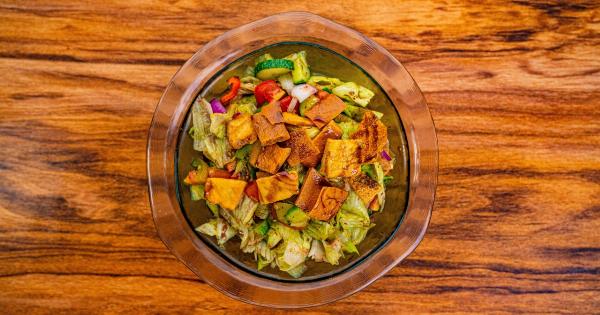Having strong and healthy bones is crucial for overall well-being and quality of life. Our bones provide structure, protect our organs, and allow us to move. As we age, our bones become more susceptible to damage and diseases such as osteoporosis.
Fortunately, adopting a bone-healthy eating plan can help support the strength and longevity of our skeletal system. In this article, we will explore the key components of a bone-healthy eating plan and provide tips for incorporating these foods into your daily diet.
1. Calcium-Rich Foods
Calcium is a vital mineral for bone health and forms the primary building block of bones. Incorporating calcium-rich foods into your diet is essential for maintaining strong bones throughout your life. Some excellent sources of calcium include:.
- Low-fat dairy products such as milk, yogurt, and cheese
- Fortified plant-based milk alternatives like almond milk or soy milk
- Leafy green vegetables such as kale, broccoli, and spinach
- Fish with edible bones such as canned salmon or sardines
- Calcium-fortified tofu and soy products
Adults should aim for a daily calcium intake of around 1000-1200 milligrams, depending on age and gender.
2. Vitamin D
Vitamin D plays a crucial role in the absorption of calcium. Without adequate vitamin D levels, our bodies cannot effectively utilize the calcium we consume.
Sunlight is the primary source of vitamin D, as our bodies can produce it when our skin is exposed to sunlight. However, certain foods can help increase our vitamin D intake:.
- Fatty fish like salmon, mackerel, and tuna
- Egg yolks
- Fortified dairy or plant-based milk alternatives
- Mushrooms
- Vitamin D supplements (consult a healthcare professional beforehand)
It is recommended that adults aim for 600-800 international units (IU) of vitamin D per day. However, if you have limited sun exposure or specific health conditions, you may require higher doses.
Consult with your healthcare provider to determine your specific vitamin D needs.
3. Magnesium and Phosphorus
Magnesium and phosphorus are two minerals that work alongside calcium to maintain strong bones and teeth. Including foods rich in these minerals in your bone-healthy eating plan is essential. Good sources of magnesium include:.
- Almonds and cashews
- Spinach and other leafy greens
- Avocado
- Whole grains
- Legumes
Similarly, phosphorus can be found in foods such as:.
- Seafood
- Lean meats and poultry
- Whole wheat products
- Dairy products
- Nuts and seeds
4. Protein
Protein is not only essential for muscle development but also for maintaining strong bones. Adequate protein intake supports bone health and helps prevent bone loss. Good sources of protein include:.
- Lean meat and poultry
- Fish and seafood
- Eggs
- Dairy products like Greek yogurt and cottage cheese
- Legumes and beans
- Tofu and tempeh
It is recommended that adults aim for 0.8 grams of protein per kilogram of body weight. However, individual protein needs may vary, so consult with a healthcare professional to determine the ideal protein intake for you.
5. Vitamin C and Antioxidants
Vitamin C is known for its immune-boosting properties, but it also plays a crucial role in collagen synthesis, a protein that provides structure to bones, tendons, and ligaments.
Including vitamin C-rich foods in your bone-healthy eating plan can help support bone health. Some excellent sources of vitamin C include:.
- Citrus fruits such as oranges and grapefruits
- Strawberries and kiwis
- Red bell peppers
- Broccoli and Brussels sprouts
- Tomatoes
Antioxidants, found in various fruits and vegetables, can help protect bone cells from oxidative stress and support overall bone health.
Be sure to incorporate a variety of colorful fruits and vegetables into your diet to obtain these valuable antioxidants.
6. Limit Sodium and Caffeine
Excessive sodium intake can cause the body to excrete more calcium, increasing the risk of bone loss. Therefore, it is essential to limit the consumption of high-sodium foods, including processed and packaged snacks, fast food, and canned soups.
Try to opt for whole, unprocessed foods and flavor your meals with herbs and spices instead of salt.
While moderate caffeine consumption is generally safe for bone health, excessive caffeine intake may hinder calcium absorption. It is advisable to limit your caffeine intake and opt for alternative beverages like herbal teas or water whenever possible.
7. Vitamin K
Vitamin K is necessary for proper bone mineralization and helps regulate calcium within the body. Leafy green vegetables are excellent sources of vitamin K, including:.
- Kale
- Spinach
- Collard greens
- Broccoli
- Brussels sprouts
By incorporating vitamin K-rich foods into your bone-healthy eating plan, you can promote optimal bone health.
8. Omega-3 Fatty Acids
Omega-3 fatty acids have been shown to have anti-inflammatory properties and can contribute to bone health. Incorporate foods rich in omega-3s into your diet, such as:.
- Fatty fish (salmon, mackerel, sardines)
- Chia seeds
- Flaxseeds
- Walnuts
- Soybeans and tofu
If you don’t consume enough omega-3-rich foods, talk to your healthcare provider about omega-3 supplements.
9. Engage in Weight-Bearing Exercises
While not directly related to the bone-healthy eating plan, engaging in weight-bearing exercises is crucial for maintaining strong bones.
Activities such as walking, jogging, dancing, or weightlifting put stress on the bones, stimulating them to become stronger.
10. Consult with a Registered Dietitian
If you have specific dietary concerns or health conditions, it is always beneficial to seek guidance from a registered dietitian.
They can tailor a bone-healthy eating plan to your individual needs, considering factors such as age, sex, overall health, and potential nutrient deficiencies.
In conclusion, adopting a bone-healthy eating plan is essential for maintaining strong and healthy bones throughout your life.
By incorporating calcium-rich foods, vitamin D sources, magnesium, phosphorus, protein, vitamin C, antioxidants, and other essential nutrients into your diet, you can support optimal bone health and reduce the risk of conditions like osteoporosis. Remember to limit sodium and caffeine intake, engage in weight-bearing exercises, and consult with a registered dietitian for personalized recommendations.































